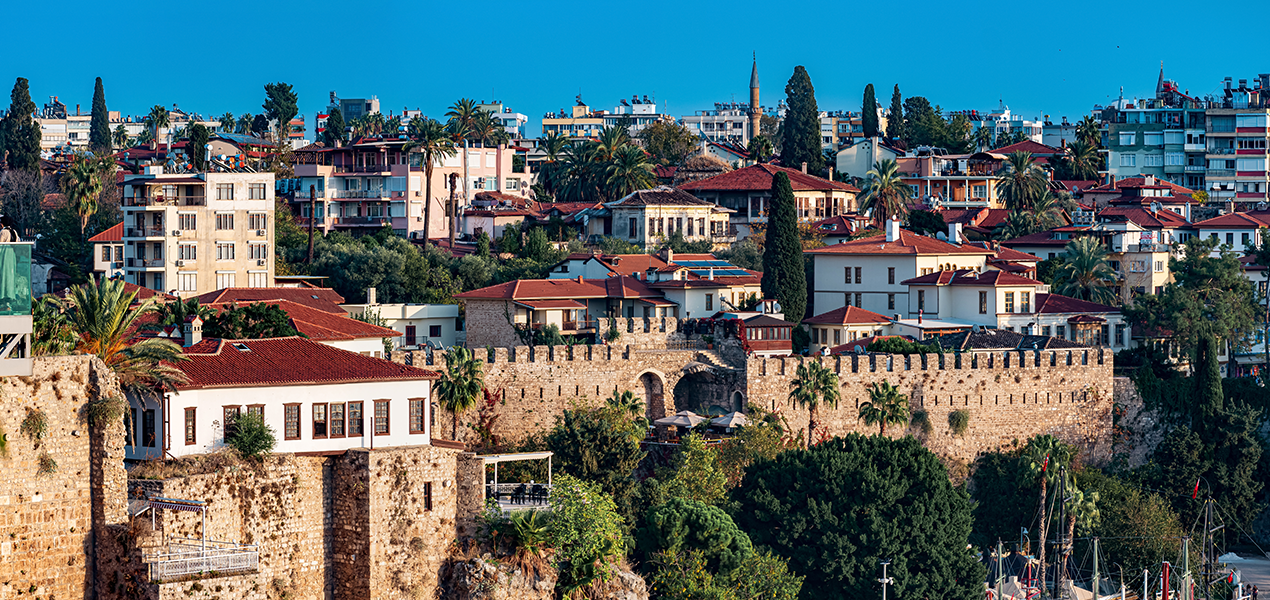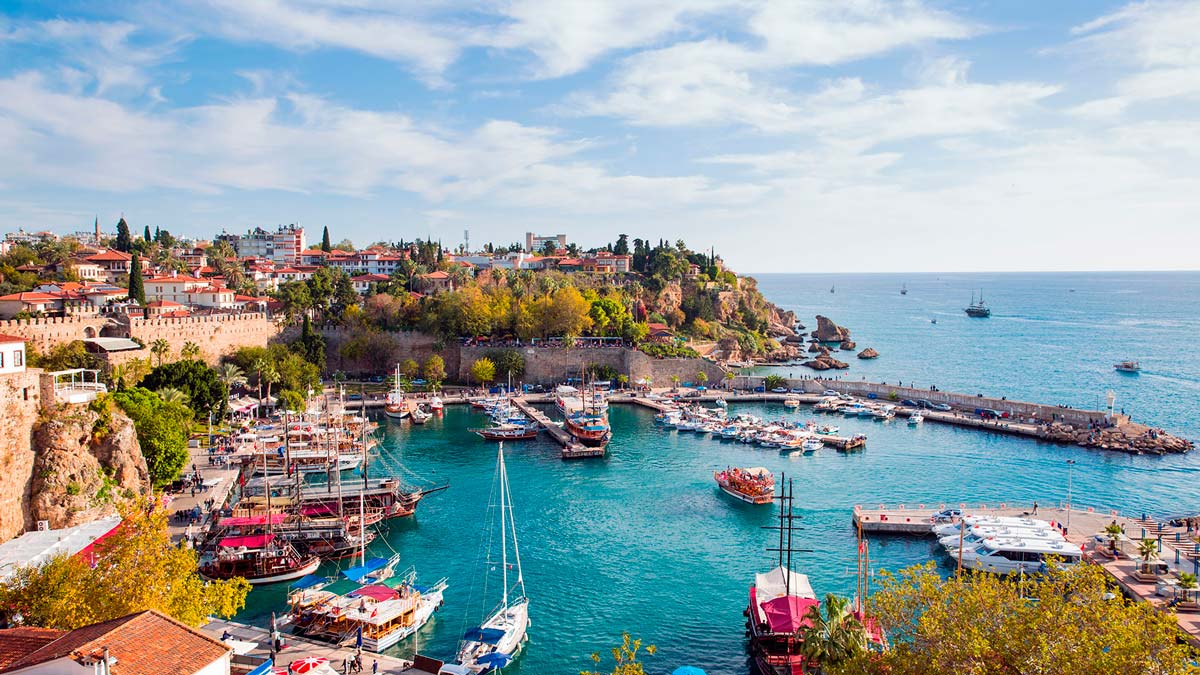When you step into Kaleiçi, the heart of Antalya, have you ever felt like you're walking not just through narrow streets, but through overlapping layers of time? On one side, the mighty marble of Rome; on another, the elegant tiles of the Seljuks; and just around the corner, the bay-windowed mansions of the Ottomans... This historical richness can be dizzying. That's why, instead of offering you a classic list of things to do in Kaleiçi, we've prepared an unforgettable historical walking route consisting of three iconic stops where you can truly feel the soul of this ancient city. This route will take you into a time tunnel stretching from the Hellenistic period to Rome, from the Seljuks to the Ottomans.
If you're ready, we'll enter through the magnificent gate of the Roman Empire, take a breath at the centuries-old Mediterranean harbor, and crown our journey with the elegant seal of the Seljuk Sultanate. This isn't just a tour; it's an invitation to witness Antalya's thousands of years of history.
Enter Through Hadrian's Gate (Üçkapılar): The First Step into Roman Splendor
The most magnificent starting point for your historical walk into Kaleiçi is undoubtedly Hadrian's Gate. Known locally as Üçkapılar (The Three Gates), this monument instantly transports you from the bustling streets of modern Antalya to the magical atmosphere of ancient times.
A Tribute to an Emperor
This is no ordinary gateway; it is a monumental triumphal arch built in 130 AD in honor of the Roman Emperor Hadrian's visit to the city. In that era, such structures were tools of propaganda, designed to showcase the empire's power, wealth, and architectural genius. As you pass under the gate, you can almost imagine the awe and pride felt by the Romans who passed through the same spot nearly 2,000 years ago.
The Anatomy of Marble and Elegance
Constructed entirely of white marble (except for its columns), the gate is dazzling with its three-arched structure. Both facades feature four columns carved in the Corinthian order, and the carvings and reliefs on them display the finesse of Roman art. It is known that the original structure was two stories high, but the upper floor has not survived to the present day; considering how impressive its current state is, it makes imagining the splendor of the original even more exciting. The fact that the gate is about 1.5 meters below the current road level due to the rising city ground over time allows you to see the layers of history in a tangible way.
The Secret of Centuries: How Was It So Well Preserved?
The secret to Hadrian's Gate surviving almost perfectly to this day is quite interesting. Over time, new city walls were built that enclosed the gate, effectively wrapping it like a shield and keeping it hidden from view for centuries. The monument was rediscovered in 1882 when these walls were demolished and achieved its current captivating appearance after a major restoration in 1959.
Two Towers, Two Civilizations: The Essence of Kaleiçi
As you approach the gate, look closely at the towers on either side. They are not just guard towers but a summary of Kaleiçi's entire history. The southern Julia Sancta Tower is a pure Roman artifact from the same period as the gate. Now turn to the northern tower; while its lower layers belong to Antiquity, the upper part was added by the Seljuk Sultan Alaaddin Keykubad I. These two towers whisper the secret of Kaleiçi to you: this is a place where civilizations did not destroy and rebuild, but rather enriched each other by building one on top of the other.

Have a Coffee with a Sea View at the Marina: A Centuries-Old Stop for Trade and Tranquility
As you pass through the stone arches of Hadrian's Gate and delve into the narrow streets of Kaleiçi, you'll feel a gentle slope pulling you towards the sea. The end of this path leads you not only to the deep blue Mediterranean but to the very reason for Antalya's existence: the historic Marina.
The Reason for Antalya's Existence
This charming harbor, where luxury yachts and tour boats now sway, is actually where Antalya was founded. Around 150 BC, King Attalos II of Pergamon discovered this natural harbor while searching for a sheltered base for his fleet and founded the city of Attaleia. This port, which was the heart of Mediterranean trade during the Roman period and served as an important naval base during the Byzantine era, has been the city's lifeline for thousands of years.
The Marina's Atmosphere, from Yesterday to Today
The atmosphere of the marina today is a perfect blend of history and modern life. On one side, you are surrounded by ancient city walls that have defied the centuries, and on the other, modern boats gently glide on the sea. In the early morning, as the city awakens, this place is a peaceful sanctuary. In the evening, it transforms into a vibrant meeting point, bustling with locals and tourists gathering to watch the sunset.
A Break Against the Backdrop of History
Now, take a seat at one of the charming cafes surrounding the harbor and order a coffee. As you watch the traditional boats and luxury yachts sway, know that you are not just admiring a view. The water you see is the same water that hosted Roman galleys, Byzantine fleets, and Ottoman merchant ships. This moment is a chance to witness 2,000 years of history and listen to the countless stories embedded in the weary stones of the harbor.
Gateways to the Blue
If you have time, you can add another dimension to your trip with daily boat tours departing from the harbor. These tours take you under Antalya's famous cliffs to the magnificent sight of the Düden Waterfalls cascading into the sea. Seeing the city from the sea gives you a much better understanding of its geographical beauty and historical location. If you'd like to have this experience, you can explore

Visit the Yivli Minare (Fluted Minaret) and its Complex: A Journey into the Heart of Seljuk Elegance
Leaving the salty scent of the harbor behind and climbing back up the stone streets of Kaleiçi, an elegant structure that defines the city's skyline will greet you on the horizon: the Yivli Minare. This minaret is not just part of a place of worship; it is the very symbol of Antalya's Seljuk identity and the city itself.
The Seljuk Seal Reaching for the Sky
Built in the 13th century during the reign of Seljuk Sultan Alaaddin Keykubad I, this unique minaret gets its name from the eight flutes that form its body. Adorned with brick and turquoise-colored tiles, this 38-meter-high structure is a masterpiece reflecting the aesthetic understanding and engineering skill of Anatolian Seljuk architecture. The minaret, which reaches the sky with its 90-step staircase, is considered the first Islamic seal stamped on the city after its conquest.
More Than a Minaret: The Concept of a 'Külliye'
The Yivli Minare does not stand alone. It is the center of a külliye, a social complex. For the Seljuks, a city center was not just a place of worship; it was a living organism that brought together all aspects of life, such as education (madrasah), spirituality (Mevlevi lodge), social life, and commemoration (tombs). This collection of buildings tells you about the Seljuk civilization's perspective on the city and its people. Now, let's explore the parts of this organism together.
Treasures of the Complex
As you wander around the minaret, you will see the other valuable structures of this historical complex:
Yivli Minare Mosque (Ulu Cami): Located just west of the minaret, this mosque is one of the oldest examples of the multi-domed mosque type in Anatolia with its six-domed structure. The simplicity and peace you will feel inside reflect the spirit of Seljuk architecture.
Madrasahs: Structures like the Gıyaseddin Keyhüsrev Madrasah served as the universities of their time and were centers of science and art.
Tombs: Mausoleums like the Zincirkıran Tomb and the Nigar Hatun Tomb show respect for the important figures of the period and add a personal touch to history.
Mevlevi Lodge: Once a spiritual center for dervishes, this building is now used as a fine arts gallery, showing how history is intertwined with modern life.
This rare example of Seljuk architecture will also make you curious about(https://www.yerelrehber.com/en/kesfet/yapilacak-seyler/yivliminare-camisi).

Conclusion: While You're Here, Explore These Nearby Spots
We have completed the main stops of our historical walk, but the magic of Kaleiçi is just beginning: it's time to get lost in its narrow streets adorned with bougainvillea. Our route has introduced you to three different civilizational layers of the city. Now it's your turn to put away the compass and explore this living museum with your instincts. Here are a few bonus suggestions:
Sunset Spot: End your walk at Karaalioğlu Park. Watching the breathtaking sunset view of the Mediterranean and the Beydağları Mountains from the park's observation terraces on the cliffs will provide an unforgettable finale to your day.
Ancient Mystery: Go to the Hıdırlık Tower, a 2nd-century Roman structure at the southwestern end of the Kaleiçi walls. Try to imagine the mystery of this tower, which is still debated whether it was a lighthouse or a monumental tomb.
Ottoman Elegance: Stroll through streets like Hesapçı or Kılıçarslan, lined with restored wooden mansions with bay windows. These houses will take you back to the daily life of the past and offer wonderful photo opportunities.
A Cultural Getaway: Examine objects related to traditional Antalya life at the Suna & İnan Kıraç Kaleiçi Museum, or take a delightful journey back to your childhood with the collection at the Antalya Toy Museum, established under the consultancy of poet Sunay Akın.
Bibliography
For more technical and historical information about Kaleiçi, you can consult the official resources of the Republic of Turkey Ministry of Culture and Tourism: Culture Portal - Kaleiçi.
Frequently Asked Questions (FAQ)
Question 1: What is the best season to visit Kaleiçi?Answer: The most pleasant times to visit Kaleiçi are in the spring (April-June) and autumn (September-October), when the weather is mild and the crowds are smaller than in the summer months. Keep in mind that it can be quite hot in the summer.
Question 2: Are the historical sites mentioned in the article free to enter?Answer: Passing through Hadrian's Gate, strolling around the Marina, and visiting the courtyard of the Yivli Minare Complex are completely free. However, there is an entrance fee for the Mevlevi Lodge (art gallery) within the complex or for private museums in Kaleiçi (such as the Suna & İnan Kıraç Museum, Toy Museum, etc.).
Question 3: Is it possible to enter Kaleiçi with a private car? Is parking an issue?Answer: Private vehicle access to the narrow streets of Kaleiçi is restricted and not recommended. The best method is to leave your car in one of the paid parking lots on the outskirts of Kaleiçi and explore this historic area on foot.


 English
English Türkçe
Türkçe